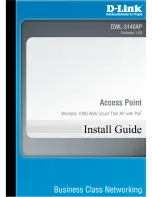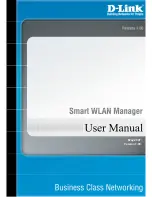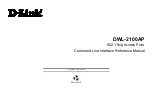
Device Configuration 5 - 259
24. Set or override the following profile
Ekahau Properties
for the selected access point radio.
25. Define a
Reduced Interframe Spacing
(RIFS) mode using the drop-down menu. This value determines whether interframe
spacing is applied to transmissions or received packets, or both or none. The default mode is Transmit and Receive.
Consider setting this value to
None
for high priority traffic to reduce packet delay.
26. Set or override the following
Non-Unicast Traffic
values for the profile’s supported access point radio and its connected
wireless clients:
27. Refer to the
Sniffer Redirect (Packet Capture)
field to define or override the radio’s captured packet configuration.
28. Select the
Enable Off-Channel Scan
radio button to scan across other channels in the radio band. This setting is disabled
by default.
29. Select the
Off-Channel Scan list for 5GHz
field and enter the channels on which off channel scan has to be performed
for the 5.0 GHz radio. Similarly select the channels for the
Off Channel Scan list for 2.4 GHz
radio.
30. Use the
Max Multicast
spinner to set the maximum number of multicast channels on which to do off channel scan.
31. Use the
Scan Interval
spinner to set the time duration in DTIM period between 2 off channel scans.
32. Use the
Sniffer Redirect
field to provide the IP address of the device to which the captured off-channel scan packets are
redirected to.
33. Select
OK
to save or override the changes to the Advanced Settings screen. Select
Reset
to revert to the last saved
configuration.
5.4.5.3.5 WAN Backhaul Overrides
Profile Interface Override Configuration
A
Wireless Wide Area Network
(WWAN) card is a specialized network interface card that allows a network device to connect,
transmit and receive data over a Cellular Wide Area Network. Certain AP7131N model access points have a PCI Express card
slot that supports 3G WWAN cards. The WWAN card uses
Point to Point Protocol
(PPP) to connect to the Internet Service
Provider (ISP) and gain access to the Internet. PPP is the protocol used for establishing internet links over dial-up modems, DSL
connections, and many other types of point-to-point communications. PPP packages your system’s TCP/IP packets and forwards
them to the serial device where they can be put on the network. PPP is a full-duplex protocol used on various physical media,
Forwarding host
Provide the IP address of the host to which Ekahau packets are forwarded to.
Forwarding Port
Use the spinner to provide the Ekahau forwarding port number.
MAC to be forwarded
Enter the MAC address that is incorporated in the Ekahau packets that are forwarded.
Non-Unicast Transmit
Rate
Use the
Select
drop-down menu to launch a sub screen to define the data rate broadcast
and multicast frames are transmitted. Seven different rates are available if the not using
the same rate for each BSSID, each with a separate menu.
Non-Unicast Forwarding
Define whether client broadcast and multicast packets should always follow DTIM, or
only follow DTIM when using Power Save Aware mode. The default setting is Follow
DTIM.
Host for Redirected
Packets
If packets are re-directed from a access point radio, define an IP address of a resource
(additional host system) used to capture the re- directed packets. This address is the
numerical (non DNS) address of the host used to capture the re-directed packets.
Channel to Capture
Packets
Use the drop-down menu to specify the channel used to capture re-directed packets. The
default value is channel 1.
Summary of Contents for WiNG 5.6
Page 1: ...Motorola Solutions WiNG 5 6 ACCESS POINT SYSTEM REFERENCE GUIDE ...
Page 2: ......
Page 22: ...8 WiNG 5 6 Access Point System Reference Guide ...
Page 26: ...1 4 WiNG 5 6 Access Point System Reference Guide ...
Page 38: ...2 12 WiNG 5 6 Access Point System Reference Guide ...
Page 74: ...3 36 WiNG 5 6 Access Point System Reference Guide ...
Page 468: ...6 2 WiNG 5 6 Access Point System Reference Guide Figure 6 1 Configuration Wireless menu ...
Page 568: ...6 102 WiNG 5 6 Access Point System Reference Guide ...
Page 614: ...7 46 WiNG 5 6 Access Point System Reference Guide ...
Page 660: ...8 46 WiNG 5 6 Access Point System Reference Guide ...
Page 716: ...9 56 WiNG 5 6 Access Point System Reference Guide ...
Page 730: ...10 14 WiNG 5 6 Access Point System Reference Guide ...
Page 982: ...14 20 WiNG 5 6 Access Point System Reference Guide ...
Page 984: ...A 2 WiNG 5 6 Access Point System Reference Guide ...
Page 1046: ...B 62 WiNG 5 6 Access Point System Reference Guide ...
Page 1047: ......
















































